Delhi: R
(→Flyover, underpass) |
(→Rajendra Nagar) |
||
| Line 55: | Line 55: | ||
As in South Extension, resident of Rajendra Nagar too complain about students who idle around and create nuisance for the general populace. “Students staying in paying guest accommodation make a lot of noise and disturbances during the night,“ adds Sharma. His plea, as of those living with the nuisance, is to nip the problem in the bud and move the coaching classes to commercial areas. | As in South Extension, resident of Rajendra Nagar too complain about students who idle around and create nuisance for the general populace. “Students staying in paying guest accommodation make a lot of noise and disturbances during the night,“ adds Sharma. His plea, as of those living with the nuisance, is to nip the problem in the bud and move the coaching classes to commercial areas. | ||
| + | |||
| + | ==The Rajendra Nagar constituency== | ||
| + | [https://timesofindia.indiatimes.com/elections/assembly-elections/delhi/all-3-players-claim-they-have-key-to-unlock-congestion-infra-woes/articleshow/73711553.cms AlokKNMishra, January 29, 2020: ''The Times of India''] | ||
| + | |||
| + | All 3 players claim they have key to unlock congestion, infra woes | ||
| + | |||
| + | Parties Rely On Youth To See Them Through | ||
| + | |||
| + | New Delhi: | ||
| + | |||
| + | Since 1993, the Rajendra Nagar constituency, in many ways, has been a stronghold of BJP, having lost there only to Congress in 2008 and then in 2015, when Aam Aadmi Party swept the capital. There’s an interesting battle brewing in the voting area named after India’s first president, Dr Rajendra Prasad, this year. AAP has dropped its sitting MLA for the youthful Raghav Chadha, against whom is ranged BJP’s former MLA R P Singh and Rocky Tuseed of Congress, the youngest among all candidates in the 2020 assembly elections. | ||
| + | |||
| + | The constituency is home to a large number of educational centres that offer coaching for civil services and law entrance exams, among other courses. The three candidates need a complex understanding of voter needs to win this seat because of the presence of a mix of economic classes. | ||
| + | |||
| + | The slum clusters at Gas Godam Jhuggi, Ratanpuri Chowk, Rajiv Gandhi Camp, Indira Camp, and other places have over 25,000 voters. The resettlement colonies constitute a significant lower middle-class vote bank, while villages such as Dashgara have a mix population of Jats and Yadavs. There are the more affluent constituents, comprising traders mostly, residing in colonies like Old Rajendra Nagar, New Rajendra Nagar, Inderpuri and Naraina Vihar. In addition, according to the estimate of political parties, the constituency also has over 20,000 Poorvanchali voters. | ||
| + | |||
| + | Between 1993 and 2008, the seat was won by BJP. But after Pandav Nagar and some parts of Karol Bagh were included in the Rajendra Nagar constituency after the delimination exercise, it was Congress breasting the tape in 2008. But having relinquished that position since, the party, which was in power for 15 years under Sheila Dikshit, aims to invest effort and energy in these polls. | ||
| + | |||
| + | AAP is depending on its performance in government in the past five years to attract votes. But in Rajendra Nagar, not everyone is happy, with many saying development was less than what they expected. Several roads, especially the inner colony lanes, are in bad shape, and though the network of water and sewer lines has been enhanced, a few localities are yet to get linked with them. | ||
| + | |||
| + | [[Category:India|D DELHI: R | ||
| + | DELHI: R]] | ||
| + | [[Category:Places|D DELHI: R | ||
| + | DELHI: R]] | ||
=Rajghat= | =Rajghat= | ||
Revision as of 19:46, 26 June 2022
This is a collection of articles archived for the excellence of their content. |
Contents |
Raj Niwas Marg
Fateh ki Kachori
The Times of India, Oct 31 2015
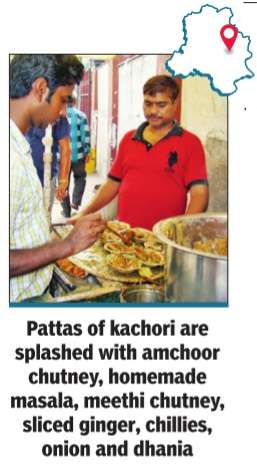
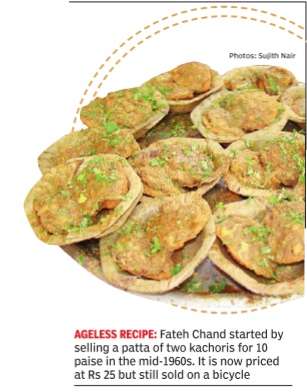
Sujith Nair At Fateh ki Kachori, it's kachori ki fateh
Five decades on, grandsons of a legend continue to sell his savoury pattas to regulars who come for a bite of nostalgia. Self-restraint kicks in only af ter you have downed at least two pattas of Fateh ki Kachori. Set on a black Neelam bicycle parked in a lane next to Raj Niwas Marg, grandsons of the late Fateh Chand don the Pied Piper's role, drawing kids from numerous schools in the neigh bourhood.
Fateh started sell ing kachori-chhole around five decade ago, carrying the delicacies on hi head and hopping from one school gate to another, before settling at the cur rent spot near Shree Delhi Gujarati Samaj. His grandson, 39-year-old Brij Mohan, better know as Toshi, says that a majority of their clients are students or alumni of these schools.
By 11am every day, regulars start trickling in as Toshi and his younger brother Bittu begin an elaborate ritual started by their maternal grandfather.A dozen pattas are laid out on a large plate; then the thin and crispy kachoris are plastered with chhole and placed on the pattas. The combo is topped with a tangy amchoor chutney and sprinkled with homemade masala -a blend of 36 spices and salts that include kaali and peeli mirch, laung, nausadar, kala namak, jeera, ajwain, and badi and chhoti elaichi. This is followed by a splash of meethi chutney and a pinch of salt, topped by a dash of freshly cut ginger, green chilli, dhania and sliced onions. The result: an extraordinary culinary adventure. linary adventure.
Sitting in an autorickshaw which doubles up as a larder, Toshi says it was Fateh's sister who first suggested the mouth-watering pairing of kachori with chhole. Fateh started by selling a patta of two kachoris for 10 paise in the mid-1960s, now it's priced at Rs 25. The cost may have gone up, but the grandsons have maintained the tradition of selling the pattas on a bicycle. A chhole-kulcha roll is the only other fare on offer. In the mid-1970s, Fateh's son, Hari Chand, branched out and started selling kachoris in United School.
Twenty years later, he moved to a spot under a neem tree opposite St.
Xavier's School in the same neigh bourhood. An ailing Hari, 64, says his relatives now sell kachoris at his spot.In his younger days, he also used to sell at Mori Gate in the evenings.
Fateh seemed to have built a legion of loyal clients in his lifetime. As kids, they used to rush to his cycle to grab a patta, and decades later, they keep returning to relive their school days.Among them is Delhi Congress chief Ajay Maken, an alumnus of St Xavier's School. Maken says he has been a regular at Fateh's since school and still relishes their kachoris.
Once done with the snacking, you could look around for the guy selling frozen fruit juice bars near one of the school gates. I couldn't resist picking up a strawberry freezer pop, for Rs 10, and then found myself chasing him for another one as he rushed to the next school gate to catch the dispersing kids. Feeling like a kid myself, I joined the stream of students heading towards Kashmere Gate Metro Station for a nostalgia-filled ride back home.
Rajendra Nagar
Coaching centres
The Times of India, Mar 10 2016
Mayank Manohar
Rajendra Nagar residents rue loss of peace
“Rajendra Nagar was always a residential area, but in past two years a large number of coaching institutes have come up in the locality,“ says Ravi Sharma, who lives in Old Rajendra Nagar.“This area used to be quiet and peaceful once, but residents are now battling with the sudden transition.“ The corporation should have not allowed even one institute to open in the residential area because once you let one in, the others follow, says Sharma. He warns that if people do not demand action at this juncture, then all the residential colonies of Delhi will gradually be overrun by such institutions. “A law should be enacted to allow coaching institutions to operate only in industrial and commercial areas,“ he says.
After the Supreme Court passed the new order on Tuesday to disbar coaching institutes from operating in residential areas, the North Delhi Municipal Corporation will ensure that appropriate actions are taken against the defaulters, reassures Rajesh Bhatia, the local councillor and member of the standing committee of the local body. “We had earlier asked the officials to take ac tion against those who were running coaching centres illegally in these places, but they failed to stop the institutes from multiplying,“ con cedes Bhatia.
Rajendra Nagar's main colony road, which once used to be sparsely used, today buzzes with students and at least 30 eateries can be found within a radius of a kilometre, causing traffic congestion and eating up all space required for parking cars.
“There is no difference between this area and Delhi University's North Campus,“ rues Savita Chaudhary , a resident. “It is not only about coaching institutes. This area is now crowded with eateries, book stores, paying guest accommodations, stationary shops and others that cater to students.“
As in South Extension, resident of Rajendra Nagar too complain about students who idle around and create nuisance for the general populace. “Students staying in paying guest accommodation make a lot of noise and disturbances during the night,“ adds Sharma. His plea, as of those living with the nuisance, is to nip the problem in the bud and move the coaching classes to commercial areas.
The Rajendra Nagar constituency
AlokKNMishra, January 29, 2020: The Times of India
All 3 players claim they have key to unlock congestion, infra woes
Parties Rely On Youth To See Them Through
New Delhi:
Since 1993, the Rajendra Nagar constituency, in many ways, has been a stronghold of BJP, having lost there only to Congress in 2008 and then in 2015, when Aam Aadmi Party swept the capital. There’s an interesting battle brewing in the voting area named after India’s first president, Dr Rajendra Prasad, this year. AAP has dropped its sitting MLA for the youthful Raghav Chadha, against whom is ranged BJP’s former MLA R P Singh and Rocky Tuseed of Congress, the youngest among all candidates in the 2020 assembly elections.
The constituency is home to a large number of educational centres that offer coaching for civil services and law entrance exams, among other courses. The three candidates need a complex understanding of voter needs to win this seat because of the presence of a mix of economic classes.
The slum clusters at Gas Godam Jhuggi, Ratanpuri Chowk, Rajiv Gandhi Camp, Indira Camp, and other places have over 25,000 voters. The resettlement colonies constitute a significant lower middle-class vote bank, while villages such as Dashgara have a mix population of Jats and Yadavs. There are the more affluent constituents, comprising traders mostly, residing in colonies like Old Rajendra Nagar, New Rajendra Nagar, Inderpuri and Naraina Vihar. In addition, according to the estimate of political parties, the constituency also has over 20,000 Poorvanchali voters.
Between 1993 and 2008, the seat was won by BJP. But after Pandav Nagar and some parts of Karol Bagh were included in the Rajendra Nagar constituency after the delimination exercise, it was Congress breasting the tape in 2008. But having relinquished that position since, the party, which was in power for 15 years under Sheila Dikshit, aims to invest effort and energy in these polls.
AAP is depending on its performance in government in the past five years to attract votes. But in Rajendra Nagar, not everyone is happy, with many saying development was less than what they expected. Several roads, especially the inner colony lanes, are in bad shape, and though the network of water and sewer lines has been enhanced, a few localities are yet to get linked with them.
Rajghat
2017: Gandhi’s quotes inscribed
Jan 30 2017, The Times of India
Mahatma Gandhi's inspiring thoughts are now displayed prominently at Rajghat. In keeping with its plans to give the memorial a facelift, the Central Public Works Department inscribed over 30 quotes by the father of the nation at the VIP entrance and other gates.
The project has been undertaken in collaboration with the Delhi Urban Art Commission. “There are eight quotes at the VIP entrance, 10-12 at one of the visitor entrances and another 7-8 at the other entrance.The quotes have been selected by the Rajghat Samadhi Samiti,“ DUAC chairperson PSN Rao said. These have been inscribed on the granite gates using white marble.
“The gates also have signatures of Bapu and his famous spectacle,“ a senior official said. As reported earlier by TOI, the security set-up of the memorial is being revamped too.
There are plans to construct a guesthouse and install a solar power system and LED lights at the complex. “A solar panel, to be installed at Rajghat's parking lot, will generate enough power to meet a part of its requirement,“ said Rao.The LED lights will help save 60,000 kWh electricty per year. “CPWD wants to revamp the iconic memorial, which today has electrical poles and wires placed in a hazardous manner,“ said an official.“There are small and dilapidated office units in a corner, which will be razed and rebuilt to conform to the surroundings. As many as 27 CCTV cameras have been installed.However, they don't cover the entire complex, but only the central areas,“ said a source.“The idea is to have complete CCTV coverage of the expanse, including the outer areas, and, so, we will put up more security cameras.“
DUAC had last year approved CPWD's plans to give the memorial a facelift, after which officials paid several visits. The work on the approved plan began in September last year. The facelift, for which the government is estimated to have spent Rs 5 crore, assumes significance because no improvement work was undertaken at Rajghat for the past 15 years.
Rajokri
2018: a renovated lake

From: Paras Singh , City govt’s water body revival project brings dead pond alive, December 28, 2018: The Times of India
Till 2017, this used to be a dirty, turbid pond fed by sewage from the nearby basti — a place where only stray cows and pigs loitered. What stands at the spot today is a landscaped community gathering spot with an artificial wetland, grassland, gravel pathways, rain gardens and a large amphitheatre.
This pond in Rajokri, on the ridge near the Gurgaon border, underwent a total transformation after it was selected as a pilot project for a decentralised mini-sewage treatment system.
It now has a 9,500sq metre redeveloped area, at the heart of which is a 2,000sq m (2 million gallon) water body fed by purified effluents from the same sewage that had earlier polluted it.
The AAP government said the Rajokri pond will now be the template for the revival of 159 other water bodies in the city — a much-needed initiative in a city where the water table is falling alarmingly.
Rajouri Garden
Main market
The Times of India, Aug 02 2015
Nona Walia
The Rajouri Garden main market has got 800 shops -36 selling jewellery, 30 shoes and more than 40 branded wedding wear -this is certainly no “neigh bourhood market“.The Rajouri Garden main market has come a long way from the days when all it offered was daily needs stuff and a basic haircut. Over the past 10 years, this west Delhi market, glamourized in movies like Queen, has become north India's prime wedding shopping destination. And it's not just Punjabi cousins from Ludhiana, Patiala and Amritsar who are crowding its streets -there are plenty ofNRIs too. This is a shaadi shopping paradise with no lean season, says Ramesh Khanna, owner of Sehej Store and president of the Main Market Traders' Association. The market has grown in size -from 214 shops in 1964 to about 800 now. But the more striking change is in the nature of the business run here. Unlike Karol Bagh, which was the original gold and trousseau market of west Delhi but didn't move with the times, Rajouri Garden has drawn big brands like Shakuntalam, Meena Bazaar, Perfection House, Manyavar, Jasmine, Bombay Selections, Appeal, Madame and Provogue.
The market also scores in terms of mood and colour. You can spot brides-to-be accompanied by their friends packing the bylanes while grooms-to-be search for sherwanis.There are mehndiwallahs on the pavement and you can also quickly learn thumka moves for the D Day from an event-organizer-turned dance teacher who has set up shop here. The market's got all bases covered from imitation jewellery to lingerie (the Bangkok variety too). “It's a one-stop shop for all wedding needs,“ says Ajay Sharma, member of the market association who owns around 10 s m a l l shops.
Fo r h e r wedding in October, Jasmine Khurana picked up a beautiful wed ding gown at a designer store that would have cost her “about Rs 1 lakh in South Exten sion but only Rs 50,000 here.“
The South-Ex resident says she decided on the Rajouri Garden mar ket because “there's no other place to shop for your wedding in Delhi. Karol Bagh is too congested and doesn't have designer brands, while in Rajouri Garden there is so much variety that I can shop in one go for myself and my tobe.“ be.“
Nishipal Bhatia, owner of SS Jewellers and SS Diamonds in Rajouri Garden, says fashion-conscious buy ers shop here for not only the discounts but also latest designs.
“People come to us from Punjab because they get only tradi tional stuff in their cities. The brides to-be buy dresses then hop over to other and then hop over to other stores to order jewellery,“ she says.
The market's appeal stretches from Ludhiana to London, says Sushma Gandhi, owner of Sawan Gandhi boutique. “I tell my clients to tell my clients to visit other mar kets first. They go to designer out lets and malls but finally find the best prices, de signs and quality here.“ Half a dozen malls -TDI Mall, TDI Paragon Mall, Shoppers Stop, City Square, West Gate Mall, and Pacific Mall have tried to follow the market's USP but failed. Gurpreet Narula, resident of Janakpuri, says, “People prefer shopping in the main market, not the malls. In fact, my aunts from Toronto shop here for their children's weddings because they get great deals.“
But the market's rapid growth in a residential area has also caused a lot of problems. Bhatia says parking and noise pollution are big problems. Khanna agrees: “The biggest problem is parking as the road is only 50-foot wide.“
Naresh Dhingra, owner of Dhingra Jewellers and a Rajouri Garden resident, says there aren't enough facilities for shoppers. “There are no toilets for women buyers for instance. Also as a resident, I find no peace in the area.“
Ramlila Maidan
Infrastructure
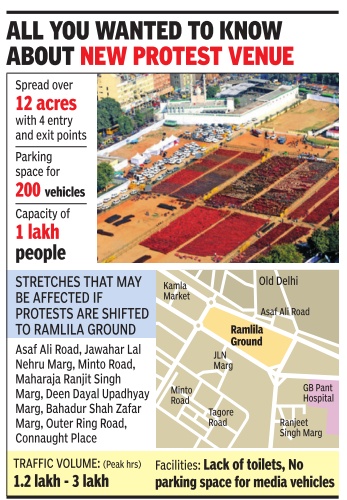
Graphic courtesy: October 29, 2017: The Times of India
See graphic, ‘The Infrastructure at Ramlila Maidan, 2017’
Rani Jhansi Road

Rani Jhansi Road grade separator project
Conceived: 1998, commissioned: 2006
Mayank Manohar, Jan 30 2017: The Times of India

Is the Rani Jhansi Road grade separator project proving another white elephant for the city?
Conceived in 1998 and commissioned by the erstwhile MCD in 2006, the flyover is yet to see the light of the day . Thanks to the delays, the cost of the project has escalated from Rs 177 crore to Rs 724 crore.
In 2016 the north corporation had announced it would throw open the muchdelayed flyover, aimed at decongesting the stretch between Pusa Road and ISBT Kashmere Gate, by January 2017.However, at least 30% of the work is yet to be completed, claimed Pravesh Wahi, standing committee chairman of the north civic body .
However, Wahi claimed that shifting of power and water utilities and the fund crunch faced by the civic body have contributed to the delay . “Acquisition of land also caused major delays as multiple agencies were involved and shifting of services of DJB and BSES took more time than we expected. Also, contractors stopped their work due to non-payment of their dues as a result of the fund crunch. Now, we are speeding up the process and there is no financial problem for the project,“ maintained Wahi.
Explaining the cost escalation, Wahi said that the construction cost was the same but the price of land had gone up due to a change in circle rates in the past one decade. This means the land acquisition cost has increased from Rs 70 crore to Rs 524 crore. The contract for the construction work was awarded to a private agency for Rs 93 crore and Rs 42 crore was deposited with the railways for carrying out construction over train tracks and other property .
Rao Tula Ram Marg
Flyover, underpass
2007-2016

See graphic:
The Rao Tula Ram flyover project: Developments between 2007 and 2016
2018: The 2year delay
Paras Singh, How RTR underpass became a 2-year-long, 100m hurdle, July 23, 2018: The Times of India
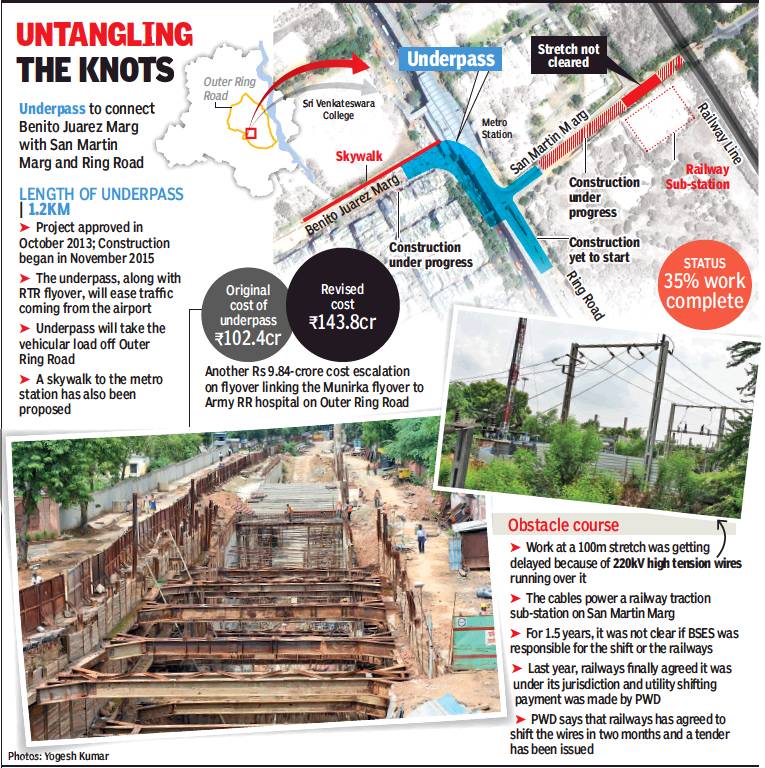
From: Paras Singh, How RTR underpass became a 2-year-long, 100m hurdle, July 23, 2018: The Times of India
The underpass project linked with the Rao Tula Ram Marg flyover construction will finally get untangled from the problem related to high-tension wires in the vicinity.
Work on around 100 metres of the underpass on San Martin Marg had been held up due to the railways’ reluctance to move the power lines feeding a traction sub-station located near the project. The Public Works Department announced that Northern Railways has now issued the tender for the work of shifting the electricity lines.
“We expect the whole complicated process of shifting the high-tension wires to be over in around two months,” a PWD official said on Wednesday. In November 2015, PWD began constructing a 1.2-kilometre underpass from Benito Juarez Road to San Martin Marg passing under Outer Ring Road. In this time, it was able to complete only 35% of the project that is designed to take vehicular load from Indira Gandhi International Airport off Outer Ring Road. The delay has resulted in a project cost escalation of Rs 40 crore.
Construction work remained struck for over two years and a half because of non-shifting of the power cables. “There was a dispute between discom BSES and Northern Railways about the jurisdiction over the 220 KV lines,” revealed an official overseeing the project. “Both claimed the cables belonged to the other. Now finally, the railways has admitted to being the owners.”
The underpass project was conceived of in 2013 alongside the skywalk taking pedestrians directly to the Durgabai Deshmukh South Campus station of Delhi Metro. The original project cost was estimated at Rs 102.4 crore, but the delay, cost of shifting utilities and tree cutting have inflated it to Rs 143.8 crore.
“Most of the cost escalation is due to the complicated shifting of utilities belonging to agencies like Delhi Jal Board, BSES and MTNL. We will not be accommodating any more cost increase after this,” the official said. Traffic police have told PWD that it will give the go ahead to dig the portion under Outer Ring Road only after the work on the sister project of the RTR flyover is completed. PWD, therefore, has been focusing on constructing the approach to the tunnel on Benito Juarez Road and San Martin Marg.
Work on the RTR flyover, meanwhile, is also languishing. Only 20 of the planned 72 spans of the elevated roadway have been erected so far. “There was a problem related to finances, but it has been resolved and should no longer hamper the pace of construction,” claimed a PWD official.
2019/ Completion, at last
July 16, 2019: The Times of India
RTR Knot: 10 Years Of TOI’s Hot Pursuit
The half-flyover was a 60cr blunder and the capital paid a heavy price as traffic crawled
T he Rao Tula Ram flyover on Outer Ring Road — just 9 metres wide and 920-metres long with three lanes — was a Rs 60-crore Commonwealth Games gift to the city. However, within days of its commissioning, it became a headache for commuters. And it was TOI which carried out a relentless campaign to highlight how ill-conceived this halfflyover was and why the authorities needed to wake up and undo the damage. Finally, on Tuesday evening, traffic will sail through this stretch. This is the story of how this was achieved.
As jams became the norm, the traffic police was at its wit’s end. The traffic flow was reversed in both directions a few times — airport to IIT and IIT to airport — but there was no easing of congestion. Finally, in December 2010, with bollards and later with jersey barriers, the carriageway was cleaved into two for two-way traffic movement.
It was clear within a few days that this could be just an interim solution. Jams mounted and residents, particularly those living in Vasant Vihar, were a harassed lot. Entering or leaving the colony became a task that tested their patience. Students of the many schools in the area were also getting caught in the gridlock. This was not conceived originally as a half-flyover. It was inaugurated in October 2009, but just six months earlier, Central Road Research Institute (CRRI) had warned that it will become a “traffic hazard” and a two-way flyover was needed. PWD had, in fact, much before the project was launched in May 2007, proposed a two-way flyover but its technical committee quite mysteriously rejected that plan in favour of a half-baked measure.
It also junked other related infrastructure projects — nine subways and four underpasses.
It was common knowledge in the department that a group of influential residents living along the road had pulled strings and prevailed upon the authorities to change their plans. The reason: they didn’t wish to part with their service lane though it was part of the 45-metre right of way (RoW) reserved for Outer Ring Road which can be used for public purpose. They also objected to the fact that the traffic would be level with their upper floors, destroying their privacy. A rock at Malai Mandir also came in the way though the temple authorities had later relented and agreed to its removal.
Even as Delhi government’s PWD dragged its feet for months over hiring RITES as a consultant to conduct a study and suggest solutions, TOI spoke to independent experts and began suggesting solutions. One prominent one was to widen the flyover by five metres on both sides to create two carriageways of threelane width. The RTR flyover is supported on cantilevers and the additional lanes could be propped up on similar supports with the traffic at the base running between them.
Finally, in December 2011, RITES was awarded the contract for a 12-month survey. By July 2012, it had proposed two solutions: Widening the existing three-lane flyover by adding three metres on each side to have a four-lane divided carriageway or creating an additional threelane flyover on a portal structure along the existing flyover to create a six-lane flyover. By September 2012, a consensus on the second plan had been achieved. Under the Rs 278-crore project, the new flyover would start near the Munirka petrol pump and end close to the Army R & R Hospital at Subroto Park.
However, the influential lobby of residents once against threw a spanner in the works by going to the LG and trying to get the width of the proposed extension reduced in order to save their service lane. This time PWD minister Raj Kumar Chauhan put his foot down.
Finally, in April 2013, the Delhi government approved the plan to construct an additional three-lane flyover parallel to the existing flyover. The LG approved this at a meeting of the apex planning body, UTTIPEC. Construction work was started in November 2014 with a deadline of November 2016. However, the project got caught in bureaucratic red tape. Permission for cutting of trees, shifting of utilities and diversion of traffic proved to be huge problems. The deadline was once again extended to December 2018. Simultaneously, a penalty – Rs 27.8 crore -- was imposed on the private contractor. The antipollution restrictions enforced by EPCA in the winter of 2018 slowed down the project considerably. TOI has been doggedly monitoring the project at every step. Three more deadlines have been crossed since then — March 2019, May 2019 and June 2019. Finally, the flyover is ready and waiting to give the city much needed relief.
The Ridge
Ashokan pillar being corroded
Richi Verma, Ashokan pillar on Ridge suffers monumental neglect, Dec 6, 2016: The Times of India
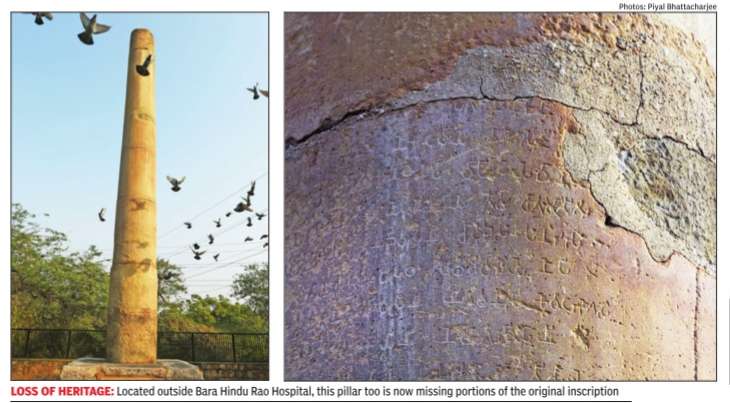
The Ashokan pillar at Kotla Ferozeshah isn't the only monument showing signs of decay; its cousin outside Bara Hindu Rao Hospital is also a victim of the vagaries of time. Inscriptions are fast disappearing, there is graffiti, and there are visible cracks on the pillar. There are also obvious signs of the use of cement mortar--a strict no-no when it comes to heritage conservation.
Archaeological Survey of India has restricted the entry to this pillar to stop people from damaging it, but historians say this one always had a turbulent history . “In the early 18th century , a gunpowder explosion had broken the pillar into five pieces. In 1867, the pieces were put back together, presumably with some sort of mortar,“ said historian and Intach convener Swapna Liddle.
There has been considerable wear and tear ever sin ce. Portions of the original inscription are missing, and one side of the pillar has graffiti etched on it. The authorities aren't sure if these are recent or much older.
ASI officials admitted that there was no documentation or monitoring of the pillar to know its change of status.“With over 3,600 monuments to conserve, it's very difficult to have periodical reviews on every site. All monuments are reviewed from time to time, but documentation done at fixed intervals isn't available,“ said a senior ASI official.
While the flaking on the Kotla pillar appears to be more recent, it would take a separate investigation to find out how things have come to such a pass at the Bara Hindu Rao pillar.
A close look at the pillar shows cement mortar, which conservationists say accelerates the deterioration of ancient monuments. “When cement mortar is used in centuries-old buildings, they react with water or anything in the air and create salts. These salts can be seen on the facade between the joints of two pieces,“ said a noted conservationist, adding, “This irreplaceable loss was totally avoidable with regular scientific monitoring and preventive conservation. The stone pillars require regular attention to mitigate the effects of pollution.Instead, they seem to have suffered from the use of chemicals and cement--both extremely harmful to them.
Ring Railway
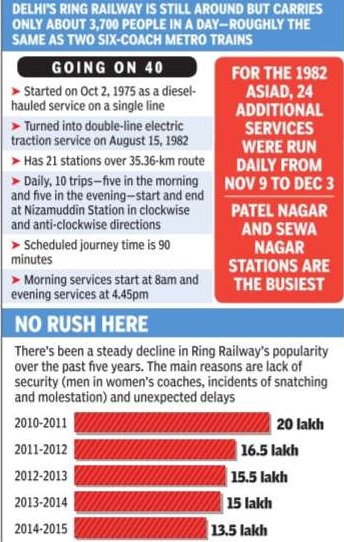
The Times of India, Aug 06 2015
Anvit Srivastava
In a city of 2.5 crore, only about 3,700 people use this 40-yearold network in a day . That's the number of people you can easily fit into two six-coach Metro trains. The service certainly looks well past its use-by date, but it had its time once. Long before Delhi got its Metro, Ring Railway served as its first, simple `mass rapid transit system'. When the services started in 1975, diesel engines hauled trains on a 35km single-line route that originated and terminated at Nizamuddin Railway Station. By August 1982, the system had a double line, shortening the travel time with clockwise and anti-clockwise trips, and the engines were electric locos.
That same year, when the Asian Games were held in winter, Ring Railway was a vital transport link to Jawaharlal Nehru Stadium and 24 additional trains were run daily from November 9 to December 3. Officials admit Ring Railway's user base has crashed.In just the past five years, annual ridership has declined by a third, from 20 lakh to 13.5 lakh.But the government isn't planning to throw it a lifeline.
“At present, we don't have any revival plan. The third phase of Metro that will connect Mayur Vihar to Lajpat Nagar and Dhaula Kuan to Rajouri Garden may result in further decline in ridership if proper connectivity is not provided,“ said Arun Arora, DRM Delhi Division, Northern Railways. He added that the railway can be revived only if there's coordination between Metro, the yetto-be-built Rail Rapid Transit System and road transport.
“Access to the existing railway stations of Ring Railway is a problem,“ said Arora. Some of these lie in secluded areas and may not be safe for women at all hours. Stations with good connectivity, like Sarojini Nagar, Lajpat Nagar, Sewa Nagar and Patel Nagar, remain popular while those in Dayabasti, Inderpuri and Kisanganj are crime-prone.